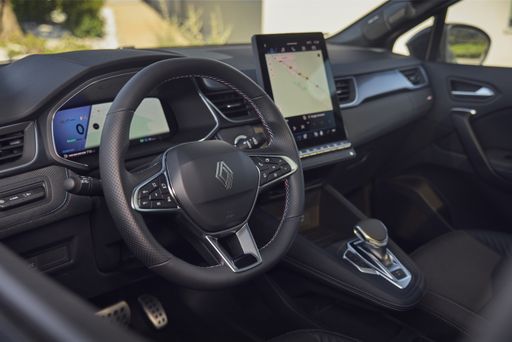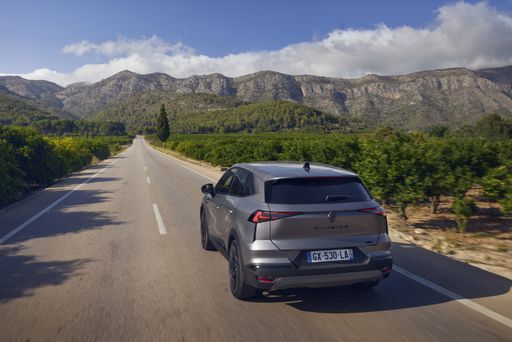Renault Symbioz vs Volvo EX30 - Differences and prices compared
Costs and Efficiency:
Price and efficiency are often the first things buyers look at. Here it becomes clear which model has the long-term edge – whether at the pump, the plug, or in purchase price.
Renault Symbioz has a distinct advantage in terms of price – it starts at 24400 £, while the Volvo EX30 costs 33000 £. That’s a price difference of around 8563 £.
Engine and Performance:
Power, torque and acceleration are the classic benchmarks for car enthusiasts – and here, some clear differences start to show.
When it comes to engine power, the Volvo EX30 has a convincingly edge – offering 428 HP compared to 158 HP. That’s roughly 270 HP more horsepower.
In acceleration from 0 to 100 km/h, the Volvo EX30 is decisively quicker – completing the sprint in 3.60 s, while the Renault Symbioz takes 9.10 s. That’s about 5.50 s faster.
In terms of top speed, the performs better – reaching , while the tops out at . The difference is around .
There’s also a difference in torque: Volvo EX30 pulls significantly stronger with 543 Nm compared to 265 Nm. That’s about 278 Nm difference.
Space and Everyday Use:
Beyond pure performance, interior space and usability matter most in daily life. This is where you see which car is more practical and versatile.
Seats: offers more seating capacity – vs .
In curb weight, Renault Symbioz is distinct lighter – 1359 kg compared to 1840 kg. The difference is around 481 kg.
In terms of boot space, the Renault Symbioz offers significantly more room – 576 L compared to 318 L. That’s a difference of about 258 L.
In maximum load capacity, the Renault Symbioz performs decisively better – up to 1682 L, which is about 682 L more than the Volvo EX30.
When it comes to payload, Renault Symbioz a bit takes the win – 459 kg compared to 390 kg. That’s a difference of about 69 kg.
Who comes out on top?
Overall, the Volvo EX30 shows itself to be is largely superior and secures the title of DriveDuel Champion.
It convinces with the more balanced overall package and proves to be the more versatile choice for everyday use.
 @ Volvo Cars
@ Volvo Cars
Volvo EX30
Costs and Consumption
View detailed analysis
Engine and Performance
View detailed analysis
Dimensions and Body
View detailed analysis
Renault Symbioz
The Renault Symbioz feels less like a traditional car and more like a rolling living room that's been told it's allowed to drive — its flowing lines and minimalist cabin are pure concept-car theatre that teases the future of everyday transport. For buyers with an eye for design and a taste for tech-forward ideas, the Symbioz is an alluring vision of what Renault could offer tomorrow, even if it's not yet a model you can park in your driveway.
details @ Renault Group Media
@ Renault Group Media
 @ Renault Group Media
@ Renault Group Media
 @ Renault Group Media
@ Renault Group Media
Volvo EX30
The Volvo EX30 arrives as a compact electric with crisp Scandinavian design and a cheeky personality, proving you can be serious about safety and still enjoy a grin on your commute. Its cabin is cleverly packaged and delightfully easy to live with, offering smart tech and practical touches that make it feel like a grown-up's city car with a sense of fun.
details @ Volvo Cars
@ Volvo Cars
 @ Volvo Cars
@ Volvo Cars
 @ Volvo Cars
@ Volvo Cars
 @ Volvo Cars
@ Volvo Cars
 @ Volvo Cars
@ Volvo Cars
 @ Renault Group Media
@ Renault Group Media
|
 @ Volvo Cars
@ Volvo Cars
|
|
|
|
Costs and Consumption |
|
|---|---|
|
Price
24400 - 30700 £
|
Price
33000 - 49100 £
|
|
Consumption L/100km
4.5 - 6 L
|
Consumption L/100km
-
|
|
Consumption kWh/100km
-
|
Consumption kWh/100km
17 - 18.7 kWh
|
|
Electric Range
-
|
Electric Range
339 - 476 km
|
|
Battery Capacity
-
|
Battery Capacity
49 - 65 kWh
|
|
co2
102 - 136 g/km
|
co2
0 g/km
|
|
Fuel tank capacity
48 L
|
Fuel tank capacity
-
|
Dimensions and Body |
|
|---|---|
|
Body Type
SUV
|
Body Type
SUV
|
|
Seats
5
|
Seats
5
|
|
Doors
5
|
Doors
5
|
|
Curb weight
1359 - 1544 kg
|
Curb weight
1840 - 1960 kg
|
|
Trunk capacity
492 - 576 L
|
Trunk capacity
318 L
|
|
Length
4413 mm
|
Length
4233 mm
|
|
Width
1797 mm
|
Width
1838 mm
|
|
Height
1575 mm
|
Height
1550 - 1567 mm
|
|
Max trunk capacity
1582 - 1682 L
|
Max trunk capacity
1000 L
|
|
Payload
376 - 459 kg
|
Payload
370 - 390 kg
|
Engine and Performance |
|
|---|---|
|
Engine Type
Full Hybrid, Petrol MHEV
|
Engine Type
Electric
|
|
Transmission
Automatic, Manuel
|
Transmission
Automatic
|
|
Transmission Detail
Automatic Gearbox, Manual Gearbox, Dual-Clutch Automatic
|
Transmission Detail
Reduction Gearbox
|
|
Drive Type
Front-Wheel Drive
|
Drive Type
Rear-Wheel Drive, All-Wheel Drive
|
|
Power HP
140 - 158 HP
|
Power HP
272 - 428 HP
|
|
Acceleration 0-100km/h
9.1 - 11 s
|
Acceleration 0-100km/h
3.6 - 5.7 s
|
|
Max Speed
180 km/h
|
Max Speed
180 km/h
|
|
Torque
250 - 265 Nm
|
Torque
343 - 543 Nm
|
|
Number of Cylinders
4
|
Number of Cylinders
-
|
|
Power kW
103 - 116 kW
|
Power kW
200 - 315 kW
|
|
Engine capacity
1332 - 1789 cm3
|
Engine capacity
-
|
General |
|
|---|---|
|
Model Year
2025
|
Model Year
2024 - 2025
|
|
CO2 Efficiency Class
C, D, E
|
CO2 Efficiency Class
A
|
|
Brand
Renault
|
Brand
Volvo
|
What drive types are available for the Renault Symbioz?
The Renault Symbioz is offered with Front-Wheel Drive.
The prices and data displayed are estimates based on German list prices and may vary by country. This information is not legally binding.
